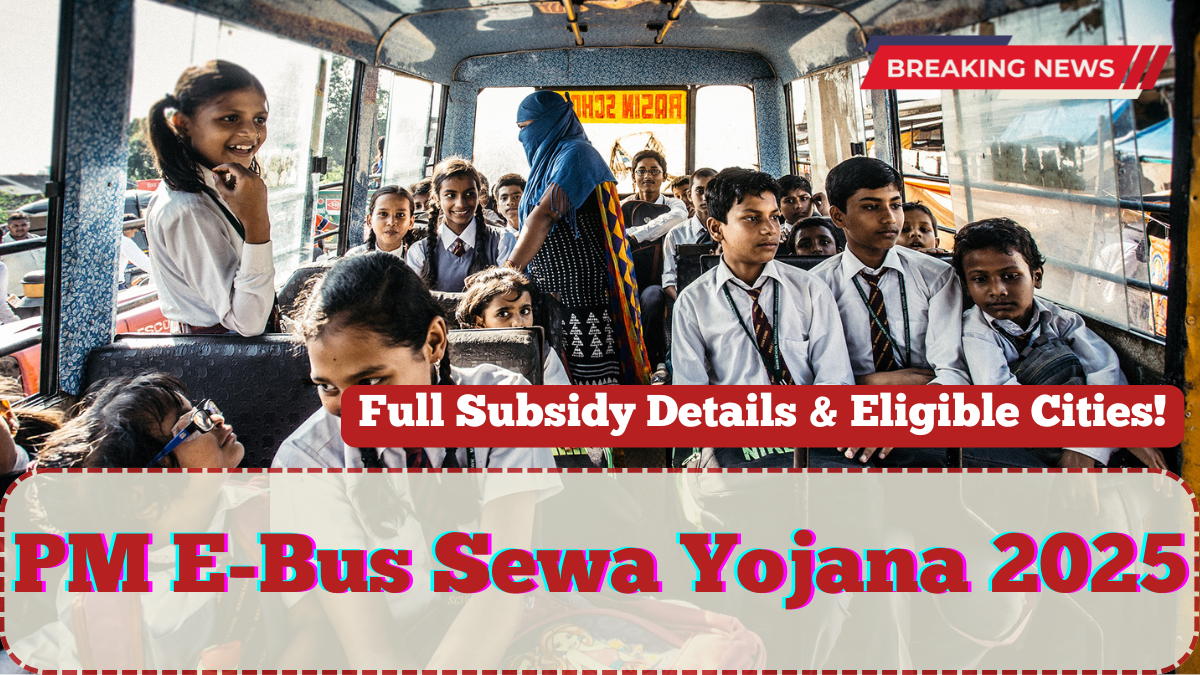The PM E-Bus Sewa Yojana 2025 is one of the most ambitious green mobility projects launched by the Indian government to transform public transportation across the country. This initiative focuses on deploying thousands of electric buses in cities, thereby reducing air pollution, cutting fuel dependence, and boosting clean urban commuting.
As part of the broader green mobility scheme, this effort also includes infrastructure development for electric charging, driver training, and state-level implementation. The electric bus subsidy India offers under this program ensures that transport authorities and local governments can afford to make the electric shift without financial strain.

Overview of PM E-Bus Sewa Yojana 2025
The PM E-Bus Sewa Yojana 2025 is a centrally-supported scheme designed to deploy 10,000 electric buses across 100 cities in India. Managed by the Ministry of Housing and Urban Affairs (MoHUA), the scheme works on a Public Private Partnership (PPP) model and includes both financial and operational support.
Core components include:
-
Capital subsidy of up to ₹50 lakh per bus
-
Viability gap funding to reduce the operational burden on state governments
-
Focus on cities with over 3 lakh population and no existing electric bus infrastructure
-
Deployment under Gross Cost Contract (GCC) model
-
Dedicated support for cities in hilly, tribal, and Tier-2 regions
This makes the electric bus subsidy India offers through the scheme one of the largest in the world in terms of volume and financial scale.
Subsidy Benefits and Government Support
The PM E-Bus Sewa Yojana 2025 offers a layered support structure to ensure ease of adoption and long-term sustainability. The funding covers both the upfront cost of the buses and part of the recurring operating costs.
Benefits include:
-
Capital subsidy of up to 40% per electric bus cost (max ₹50 lakh)
-
Support for bus depots, charging stations, and maintenance hubs
-
Encouragement for Make in India components and battery manufacturing
-
Training for drivers and technicians to handle electric vehicles
-
Priority access to central support for cities in low-income zones
This green mobility scheme promotes sustainability while creating employment in the electric vehicle ecosystem.
List of Eligible Cities Under the Scheme
The first phase of the PM E-Bus Sewa Yojana 2025 targets 100 cities, divided into various categories based on population, urban planning, and public transport gaps.
Some key eligible cities include:
-
Tier-1 Metro Cities: Delhi, Mumbai, Bengaluru, Hyderabad, Chennai, Ahmedabad, Pune
-
Tier-2 & 3 Cities: Nagpur, Lucknow, Bhopal, Surat, Indore, Jaipur, Patna, Bhubaneswar, Kochi
-
Northeast and Hilly Areas: Shillong, Gangtok, Itanagar, Shimla, Dehradun
-
Tribal Belt Regions: Raipur, Ranchi, Jamshedpur, Udaipur, Korba
Each selected city is responsible for infrastructure readiness and signing MOUs with the central government for the rollout. As of now, over 7,000 buses have already been sanctioned, and delivery is in progress across several cities.
Impact of the Scheme on Indian Public Transport
The PM E-Bus Sewa Yojana 2025 is already changing the face of urban mobility in India. With a sharp focus on low-emission transportation, the program is reducing carbon footprints while modernizing how India commutes.
Real-world outcomes observed:
-
Over 2000 e-buses operational by mid-2025
-
Average CO₂ emission reduction of 800 kg per bus per day
-
Improvement in punctuality and comfort in city bus services
-
Reduced noise and air pollution in congested urban zones
-
Rising employment in EV maintenance, battery tech, and charging infra
This makes the PM E-Bus Sewa Yojana 2025 not just a transport project, but a long-term solution for environmental health, mobility equity, and sustainable growth.
FAQs
What is the PM E-Bus Sewa Yojana 2025?
It is a government scheme to deploy 10,000 electric buses in Indian cities with financial and infrastructure support for clean, sustainable public transport.
Who is eligible to receive the electric bus subsidy India offers?
Municipal corporations and city transport agencies in Tier-1, Tier-2, and hilly/tribal cities are eligible under the scheme.
How much subsidy is provided for each electric bus?
Up to ₹50 lakh per bus is offered as a capital subsidy, along with operational viability gap funding.
Which cities are selected under the scheme?
The scheme covers 100 cities across India, including Delhi, Mumbai, Bengaluru, Lucknow, Kochi, and Dehradun, among others.
What is the goal of this green mobility scheme?
The goal is to reduce urban pollution, shift to electric public transport, create green jobs, and build sustainable infrastructure.
Click here to know more.
